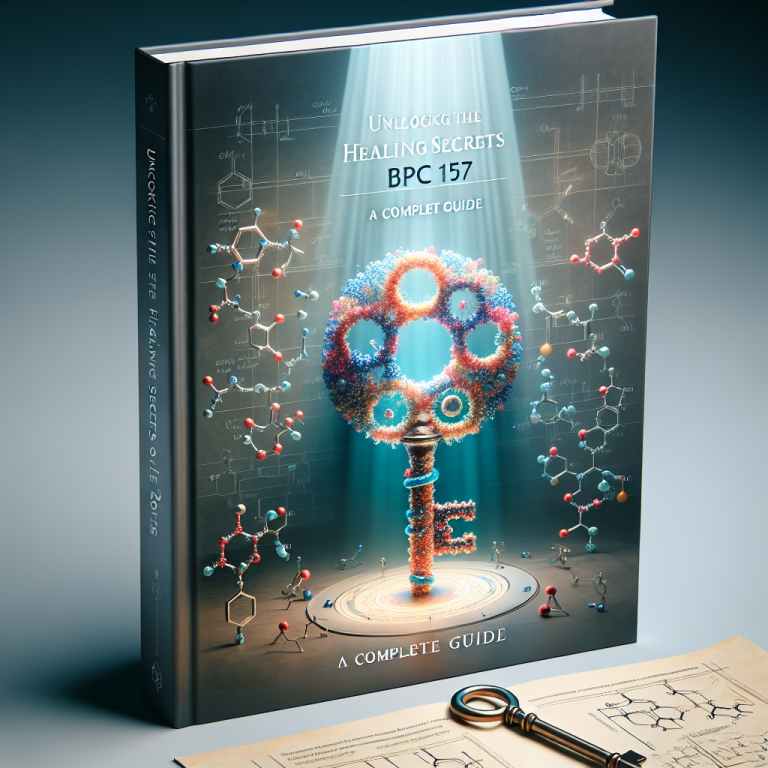Understanding BPC-157: A Comprehensive Guide to Its Healing Properties
BPC-157, a synthetic peptide composed of 15 amino acids, is a partial sequence of body protection compound (BPC) that can be found naturally in human gastric juice. It has drawn significant attention in the scientific community for its remarkable healing properties, particularly in terms of tissue repair and regeneration. This peptide has become a subject of interest not only among researchers but also among those seeking advanced methods to accelerate the healing process of various injuries and conditions.
The primary appeal of BPC-157 lies in its ability to promote the healing of different types of tissues, including muscle, skin, bone, and ligaments. Studies have demonstrated that this peptide facilitates the healing process by stimulating angiogenesis, the development of new blood vessels, which enhances blood flow to damaged tissues. This is crucial for delivering nutrients and oxygen, both vital for repair and regeneration. Additionally, BPC-157 has been shown to upregulate growth factors, which are proteins that play critical roles in maintaining healthy cells and tissues.
Another significant aspect of BPC-157's action is its anti-inflammatory properties. Inflammation is a natural response of the body to injury and infection, but excessive inflammation can lead to prolonged pain and delayed healing. BPC-157 helps modulate this response, reducing excessive inflammatory processes and thereby aiding in quicker recovery. This characteristic makes it particularly appealing for treating conditions such as arthritis where inflammation plays a key role in symptom severity and disease progression.
Moreover, BPC-157 has been observed to have protective effects on organs and to counteract the adverse effects of certain toxins on the body. For instance, research indicates that it can protect the gut and liver from damage caused by non-steroidal anti-inflammatory drugs (NSAIDs), a common medication used to treat pain and inflammation that can have detrimental effects on the gastrointestinal tract and liver with long-term use.
The mechanism through which BPC-157 exerts its effects is believed to involve the modulation of several pathways associated with cellular survival and cytoprotection. It interacts with the nitric oxide system, promotes the expression of genes involved in antioxidant production, and regulates several enzymes that play roles in inflammation and tissue healing. These interactions contribute to its wide-ranging benefits in tissue repair and protection against injury.
Despite its promising potential, it is important to note that the majority of research on BPC-157 has been conducted in animal models. While these studies provide valuable insights into the peptide's mechanisms and potential applications, clinical trials are necessary to fully understand its efficacy and safety in humans. Such trials will help determine the optimal dosing, administration routes, and treatment regimens for various conditions.
In conclusion, BPC-157 offers a multifaceted approach to healing and recovery through its tissue-regenerative, anti-inflammatory, and protective properties. Its ability to enhance the healing of numerous types of tissues while also reducing inflammation and protecting organs makes it a compelling subject for further research. As science continues to unlock the full potential of this peptide, it holds the promise of becoming a significant tool in medical therapeutics, potentially improving outcomes for patients with a variety of injuries and conditions.
The Science Behind BPC-157: How It Promotes Tissue Repair and Regeneration

BPC-157, a pentadecapeptide composed of 15 amino acids, has garnered significant attention in the scientific community due to its remarkable potential in promoting tissue repair and regeneration. This peptide is a synthetic compound derived from a protein naturally found in gastric juice, which has been shown to possess various biological and healing properties, particularly in accelerating the healing processes of the body.
Central to the functionality of BPC-157 is its unique influence on the body’s angiogenic repair mechanisms. Angiogenesis, the process through which new blood vessels form from pre-existing vessels, is crucial for healing as it supplies necessary nutrients and oxygen to damaged tissues. BPC-157 enhances this process, thereby improving the rate and extent of recovery from injuries. Studies have demonstrated that when administered, BPC-157 stimulates the formation of endothelial cells, which are essential components in the vascular growth necessary for tissue repair and regeneration.
Another pivotal aspect of BPC-157’s action is its modulation of the body's production of nitric oxide, a molecule that plays a significant role in vascular health and wound healing. By promoting increased levels of nitric oxide, BPC-157 helps in reducing blood pressure within the vessels, thus facilitating a smoother flow of blood. This action not only aids in faster delivery of essential nutrients to injuries but also assists in the removal of waste products from the cells, which is vital for effective healing.
Moreover, BPC-157 has shown promising results in the protection and healing of tissues beyond just the vascular system. For instance, in studies involving damage to ligaments and tendons, which are typically slow to heal due to poor blood supply, BPC-157 has accelerated healing by promoting cell survival and migration. This is particularly relevant in sports medicine and physical therapy where quick recovery is crucial.
Furthermore, its regenerative capabilities are not limited to soft tissues; BPC-157 has also been observed to have bone-healing properties. Research indicates that BPC-157 enhances the expression of genes involved in the formation of bone tissue, a process known as osteogenesis. This finding could have significant implications for treating conditions like osteoporosis and other bone-related disorders, where the regeneration of bone tissue is compromised.
The molecular mechanisms underlying these effects involve the upregulation of growth factors such as VEGF (vascular endothelial growth factor), which directly contributes to angiogenesis and tissue healing. Additionally, BPC-157 influences several pathways that control cell growth and survival, offering protection against cellular stress and toxins.
Despite these promising findings, the clinical applications of BPC-157 are still under extensive investigation. Most of the current knowledge derives from preclinical studies conducted in animal models, and substantial work is required to translate these effects into safe and effective therapeutic strategies for human use. Ongoing clinical trials are focused on determining optimal dosages, potential side effects, and long-term safety profiles.
In conclusion, BPC-157 presents a compelling case for its use in tissue repair and regeneration, with its multifaceted approach to enhancing healing processes. By promoting angiogenesis, facilitating better blood flow, and stimulating cellular growth and survival, BPC-157 holds potential not only in treating a range of injuries and disorders but also in revolutionizing aspects of regenerative medicine. As research progresses, it will be crucial to monitor how these laboratory successes translate into clinical treatments, potentially offering new hope for rapid and effective recovery in patients suffering from various tissue injuries.
BPC-157 in Sports: Enhancing Recovery and Performance Safely
BPC-157, a peptide composed of 15 amino acids, has been gaining attention in the sports community for its potential to enhance recovery and improve performance while adhering to safety standards. This peptide, derived from a protein found in stomach acid, has been the subject of various studies due to its healing properties, particularly in soft tissues. As athletes continuously seek methods to expedite recovery and boost performance, BPC-157 offers a promising avenue without the severe side effects associated with other performance enhancers.
The primary appeal of BPC-157 lies in its ability to significantly enhance the body's natural healing processes. Research indicates that it promotes the repair of muscles, tendons, and even bones, which are crucial for athletes who regularly subject their bodies to high levels of physical stress. This can reduce recovery times dramatically, allowing athletes to return to training and competition more swiftly. Moreover, BPC-157 has been shown to improve angiogenesis, the process through which new blood vessels form, thereby increasing blood flow to damaged tissues and further facilitating the healing process.
This peptide also exhibits protective effects against injuries. By strengthening the integrity of the vascular system and improving the resilience of tissues to damage, BPC-157 can help athletes not only recover from injuries but also potentially prevent them. This dual action makes it an invaluable tool in an athlete's regimen, particularly in sports that carry a high risk of injury.
Despite its potent healing and protective capabilities, BPC-157 does not carry the stigma of many performance-enhancing drugs (PEDs). It does not affect hormones like traditional steroids, which can lead to significant and harmful side effects. Instead, BPC-157 works by enhancing the body's existing pathways for repair and protection. This aspect of BPC-157 is particularly crucial as it aligns with the clean sport initiative, which promotes the achievement of athletic excellence without the use of banned substances.
However, the conversation around BPC-157 in sports is not without controversy. While it is not currently listed as a banned substance by major anti-doping agencies, the ethical implications of its use are still debated. Some argue that any form of biological intervention that significantly enhances performance could be considered unfair. On the other hand, supporters of BPC-157 suggest that its use is akin to other accepted medical treatments that aid in recovery.
Further complicating the issue is the regulatory status of BPC-157. As of now, it is primarily available through research channels and is not approved by major drug regulatory bodies like the FDA for widespread medical use. This lack of approval raises concerns about the purity and dosage of BPC-157 products available on the market, which could pose health risks to athletes.
In conclusion, BPC-157 presents a compelling option for athletes looking to safely enhance recovery and improve performance through natural healing processes. Its ability to expedite recovery, protect against injuries, and do so without disrupting hormonal balance makes it an attractive, if somewhat controversial, tool in sports. As research continues and regulatory perspectives evolve, the role of BPC-157 in sports will likely become clearer, potentially reshaping how athletes approach recovery and performance enhancement in the future.

